Ditapis dengan
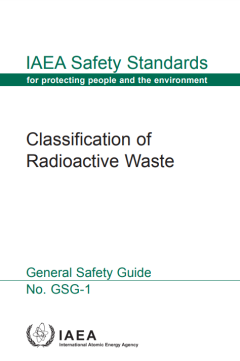
IAEA - Safety Standards Series No. GSG-1 : CLASSIFICATION OF RADIOACTIVE WAST…
This publication is a revision of an earlier Safety Guide of the same title issued in 1994. It recommends revised waste management strategies that reflect changes in practices and approaches since then. It sets out a classification system for the management of waste prior to disposal and for disposal, driven by long term safety considerations. It includes a number of schemes for classifying rad…
- Edisi
- -
- ISBN/ISSN
- 978–92–0–109209–0 / 1020–525X
- Deskripsi Fisik
- 68 p
- Judul Seri
- -
- No. Panggil
- 363.7289 IAE S
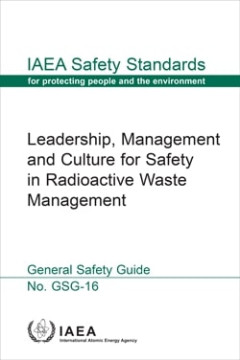
Leadership, Management and Culture for Safety in Radioactive Waste Management…
This Safety Guide provides recommendations on how to comply with IAEA safety requirements on leadership and management for safety in the area of radioactive waste management. It presents updated guidance on developing and implementing management systems for safety during all steps of radioactive waste management. Emphasis is placed upon effective leadership and culture for safety. The publicati…
- Edisi
- -
- ISBN/ISSN
- 978–92–0–137521–6
- Deskripsi Fisik
- 99 p
- Judul Seri
- IAEA safety standards series
- No. Panggil
- 621.039.7 IAE l
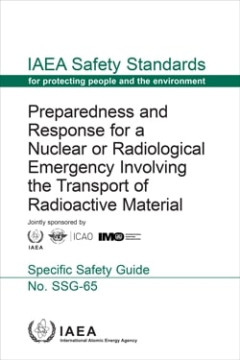
Preparedness and Response for a Nuclear or Radiological Emergency Involving t…
Radioactivity is a natural phenomenon and natural sources of radiation are features of the environment. Radiation and radioactive substances have many beneficial applications, ranging from power generation to uses in medicine, industry and agriculture. The radiation risks to workers and the public and to the environment that may arise from these applications have to be assessed and, if necessar…
- Edisi
- -
- ISBN/ISSN
- 978–92–0–127621–6
- Deskripsi Fisik
- 91 p
- Judul Seri
- IAEA safety standards series
- No. Panggil
- 614.876 IAE p
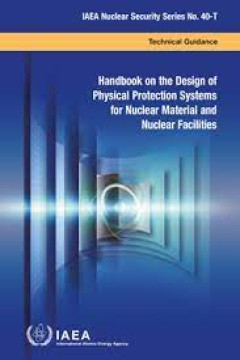
Handbook on the Design of Physical Protection Systems for Nuclear Material an…
This publication provides comprehensive detailed guidance for States, competent authorities and operators on how to implement the recommendations and implementing guidance of existing IAEA Nuclear Security Series publications for an effective physical protection system (PPS) for nuclear facilities and nuclear materials in use and storage. It provides further technical detail on how to design an…
- Edisi
- 2021
- ISBN/ISSN
- 978-92-0-100120-7
- Deskripsi Fisik
- 200 p
- Judul Seri
- IAEA Nuclear Security Series No. 40-T
- No. Panggil
- 621.039.58
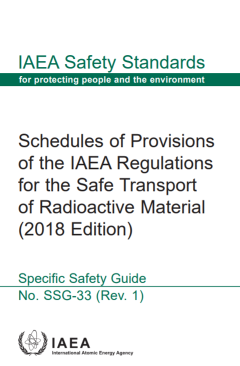
Schedules of provisions of the IAEA regulations for the safe transport of ra…
Radioactivity is a natural phenomenon and natural sources of radiation are features of the environment. Radiation and radioactive substances have many beneficial applications, ranging from power generation to uses in medicine, industry and agriculture. The radiation risks to workers and the public and to the environment that may arise from these applications have to be assessed and, if necessar…
- Edisi
- 2021
- ISBN/ISSN
- 978-92-0-121921-3
- Deskripsi Fisik
- 322 p
- Judul Seri
- IAEA Safety Standards Series No. SSG-33 (Rev. 1)
- No. Panggil
- 656.073 IAE s
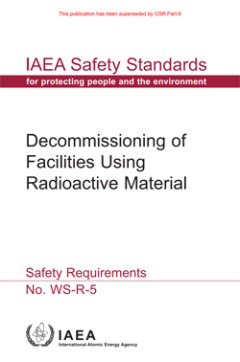
Safety Standards-Safety Requirements Decommisioning of Facilities Using Radio…
The importance of decommissioning has come to the fore in the past few years. Previously the requirements for safety during decommissioning had been considered as part of general waste management, but recently it was decided that this important part of a facility’s life needs to have definitive requirements specified. This publication provides such information.
- Edisi
- -
- ISBN/ISSN
- -
- Deskripsi Fisik
- 25 Hal
- Judul Seri
- -
- No. Panggil
- -

IAEA - Safety Standards Series No. GSR Part 5 : PREDISPOSAL MANAGEMENT OF RAD…
This Safety Requirements publication applies to the predisposal management of radioactive waste of all types and covers all the steps in its management from its generation up to its disposal, including its processing (pretreatment, treatment and conditioning), storage and transport. Such waste may arise from the commissioning, operation and decommissioning of nuclear facilities; the use of radi…
- Edisi
- -
- ISBN/ISSN
- 978–92–0–111508–9 / 1020–525X
- Deskripsi Fisik
- 56 p
- Judul Seri
- -
- No. Panggil
- -
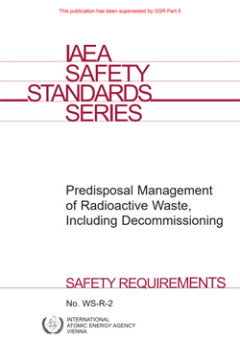
IAEA Safety Standards Series.Safety Requirements No.WS-R-2.Predisposal Manage…
This publication establishes safety requirements relating to the predisposal management of radioactive waste arising from: the operation and decommissioning of nuclear facilities; the application of radionuclides in industry, medicine and research; the processing of raw materials containing naturally occurring radionuclides; and the cleanup of contaminated sites. Safety requirements for the rel…
- Edisi
- -
- ISBN/ISSN
- 92-0-100300-5
- Deskripsi Fisik
- 26 Halaman
- Judul Seri
- -
- No. Panggil
- -
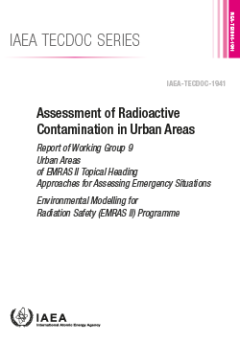
Assessment of Radioactive Contamination in Urban Areas - IAEA TECDOC No. 1941
Radiological environmental impact assessment models are important tools to ensure protection of the public and the environment. The IAEA has an ongoing programme to improve capabilities in this area by model testing and comparison, reaching consensus on modelling philosophies, approaches and parameter values. This publication describes and summarizes the findings of Working Group 9 carried out …
- Edisi
- -
- ISBN/ISSN
- 978-92-0-134221-8
- Deskripsi Fisik
- -
- Judul Seri
- -
- No. Panggil
- -

Release of Sites from Regulatory Control on Termination of Practices, Safety …
An increasing number of nuclear facilities are coming to the end of their useful lives and are being, or are going to be, decommissioned with a view to removing the sites from regulatory control. In many cases, decommissioning activities include the decontamination of land, buildings and other structures such as underground pipes and tanks, or ponds, at the site that became contaminated as a re…
- Edisi
- -
- ISBN/ISSN
- 9201016069 / 1020525X
- Deskripsi Fisik
- 37 p. : Illus. ; 24 cm
- Judul Seri
- Safety Standards No. WS-G-5.1
- No. Panggil
- -
 Karya Umum
Karya Umum  Filsafat
Filsafat  Agama
Agama  Ilmu-ilmu Sosial
Ilmu-ilmu Sosial  Bahasa
Bahasa  Ilmu-ilmu Murni
Ilmu-ilmu Murni  Ilmu-ilmu Terapan
Ilmu-ilmu Terapan  Kesenian, Hiburan, dan Olahraga
Kesenian, Hiburan, dan Olahraga  Kesusastraan
Kesusastraan  Geografi dan Sejarah
Geografi dan Sejarah